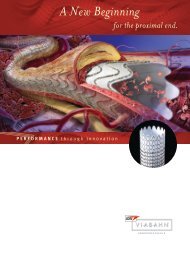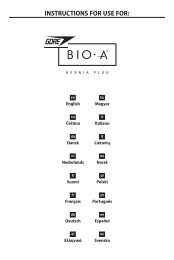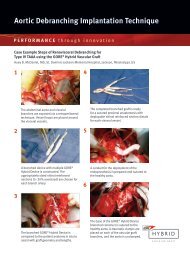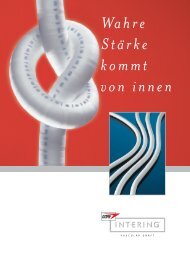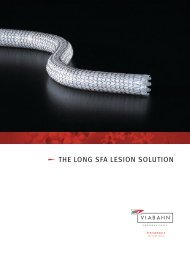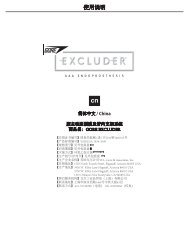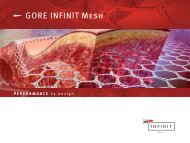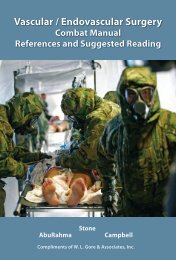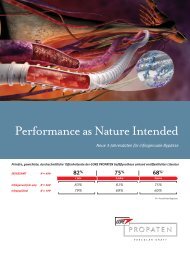GORE RESOLUT XT Regenerative Membrane ... - Gore Medical
GORE RESOLUT XT Regenerative Membrane ... - Gore Medical
GORE RESOLUT XT Regenerative Membrane ... - Gore Medical
You also want an ePaper? Increase the reach of your titles
YUMPU automatically turns print PDFs into web optimized ePapers that Google loves.
• In the event of tissue inflammation or evidence of infection, and<br />
at the clinician’s discretion, the membrane may be removed. <strong>GORE</strong><br />
<strong>RESOLUT</strong>® <strong>XT</strong> <strong>Regenerative</strong> <strong>Membrane</strong> undergoes hydrolytic and<br />
enzymatic breakdown during bioabsorption and, therefore, loses its<br />
structural integrity. Removal of the membrane may require curettage<br />
and should be accompanied by thorough flushing with sterile saline.<br />
• It is recommended not to debride the site for at least one year<br />
following guided tissue regeneration.<br />
evaLUatIon oF ResULts<br />
• Sites treated with <strong>GORE</strong> <strong>RESOLUT</strong>® <strong>XT</strong> <strong>Regenerative</strong> <strong>Membrane</strong><br />
should not be probed for at least six months.<br />
• Gain in attachment level, decreased probing pocket depth, and<br />
overall health of the site are effective measurements of determining<br />
success of the procedure.<br />
• Radiographs can be taken to evaluate bone fill 12 to 18 months postsurgery.<br />
<strong>Regenerative</strong> healing has been shown to continue over this<br />
timeframe.<br />
aDveRse ReactIons<br />
Possible complications with any periodontal surgery include thermal<br />
sensitivity, gingival recession, flap sloughing, resorption or ankylosis<br />
of the treated root, some loss of crestal bone height, perforation or<br />
abscess formation, infection, pain, swelling, inflammation, gingival<br />
irregularities, and complications associated with the use of anesthesia.<br />
Depending on the type and severity of the complication, as judged by<br />
the clinician, membrane removal or antibiotic therapy may be indicated<br />
(please refer to section on post-operative reminders).<br />
GoRe ResoLUt® sUtURe<br />
DescRIptIon<br />
Braided <strong>GORE</strong> <strong>RESOLUT</strong>® synthetic absorbable surgical sutures are<br />
composed of the homopolymer of glycolic acid and coated with<br />
POLYCAPROLATE® Coating System, a copolymer of glycolide and<br />
epsilon-caprolactone.<br />
The POLYCAPROLATE® Coating System is inert, noncollagenous and<br />
nonantigenic.<br />
The sutures are sterile, inert, noncollagenous and nonantigenic. <strong>GORE</strong><br />
<strong>RESOLUT</strong>® Sutures are available in the undyed natural beige color.<br />
<strong>GORE</strong> <strong>RESOLUT</strong>® Sutures meet all requirements established by the<br />
United States Pharmacopoeia (USP) and European Pharmacopoeia (EP)<br />
for synthetic absorbable surgical sutures.<br />
InDIcatIons<br />
<strong>GORE</strong> <strong>RESOLUT</strong>® Sutures are indicated for use as absorbable sutures<br />
in general soft tissue approximation and / or ligation, including use<br />
in ophthalmic procedures, but not for use in cardiovascular or neural<br />
tissue.<br />
actIons<br />
<strong>GORE</strong> <strong>RESOLUT</strong>® Sutures elicit a minimal acute inflammatory reaction<br />
in tissues, which is followed by gradual encapsulation of the suture<br />
by fibrous connective tissue. Progressive loss of tensile strength and<br />
eventual absorption of <strong>GORE</strong> <strong>RESOLUT</strong>® Sutures occur by means of<br />
hydrolysis, where the polymer degrades to glycolic acid which is<br />
subsequently absorbed and metabolized by the body. The absorption<br />
process begins as a loss of tensile strength followed by a loss of mass.<br />
Subcutaneous implantation studies in rats indicate <strong>GORE</strong> <strong>RESOLUT</strong>®<br />
Sutures retain approximately 65% of the original tensile strength at two<br />
weeks post implantation, with approximately 35% remaining at three<br />
weeks. Animal studies demonstrate absorption of <strong>GORE</strong> <strong>RESOLUT</strong>®<br />
Sutures is essentially complete between 60 and 90 days.<br />
3




